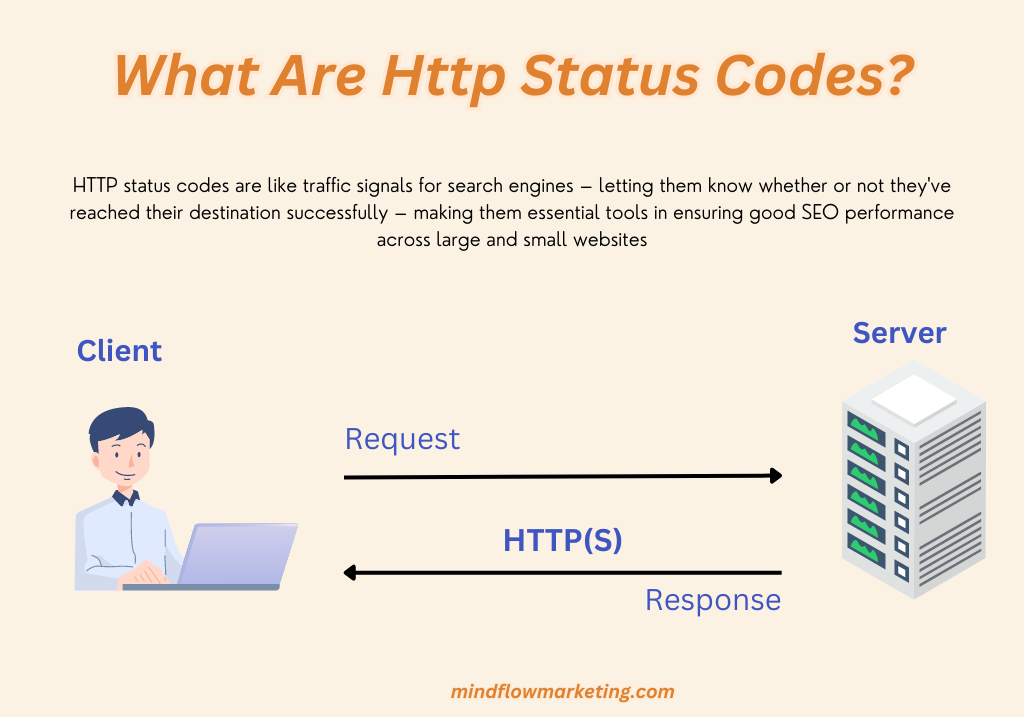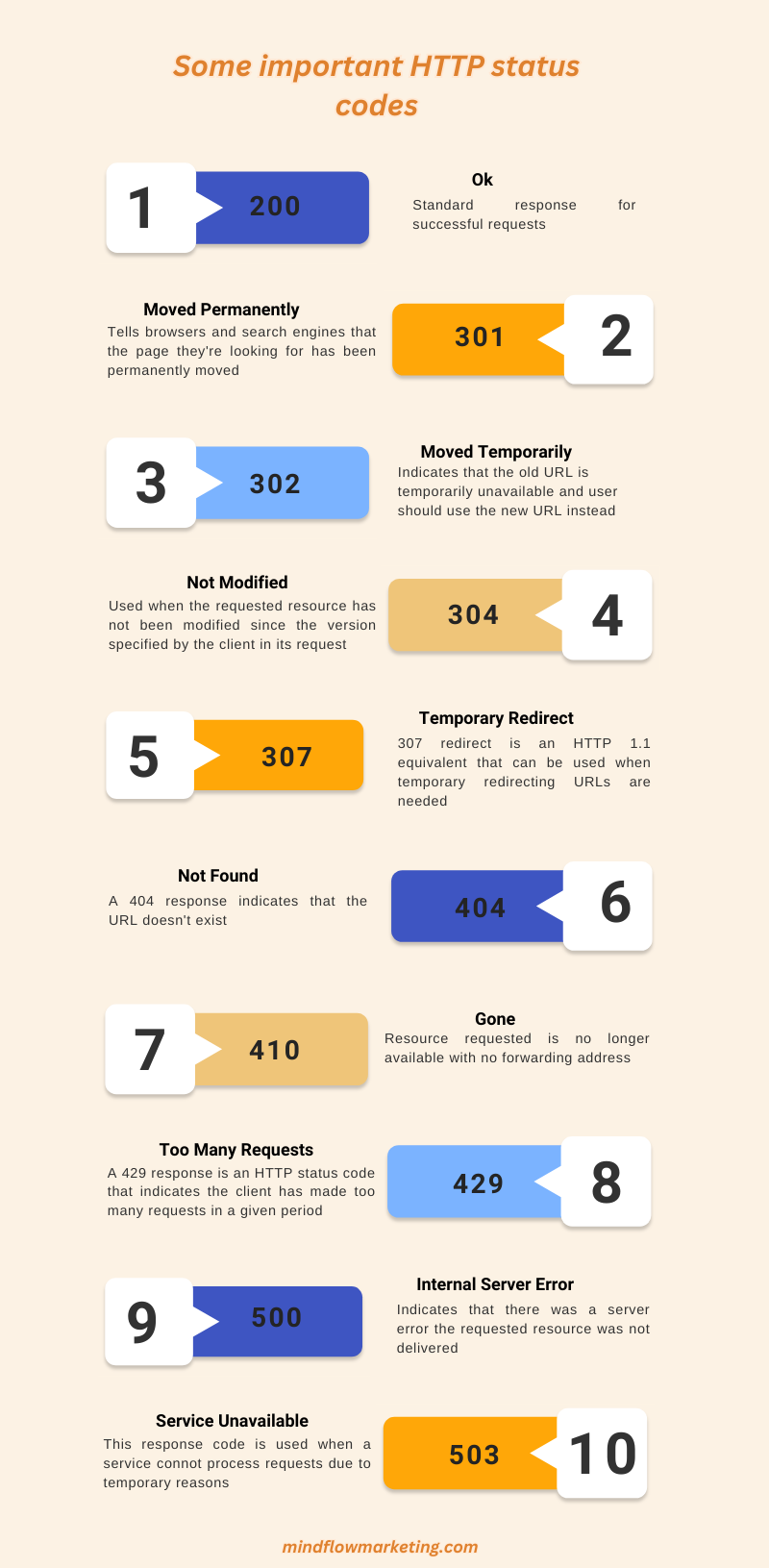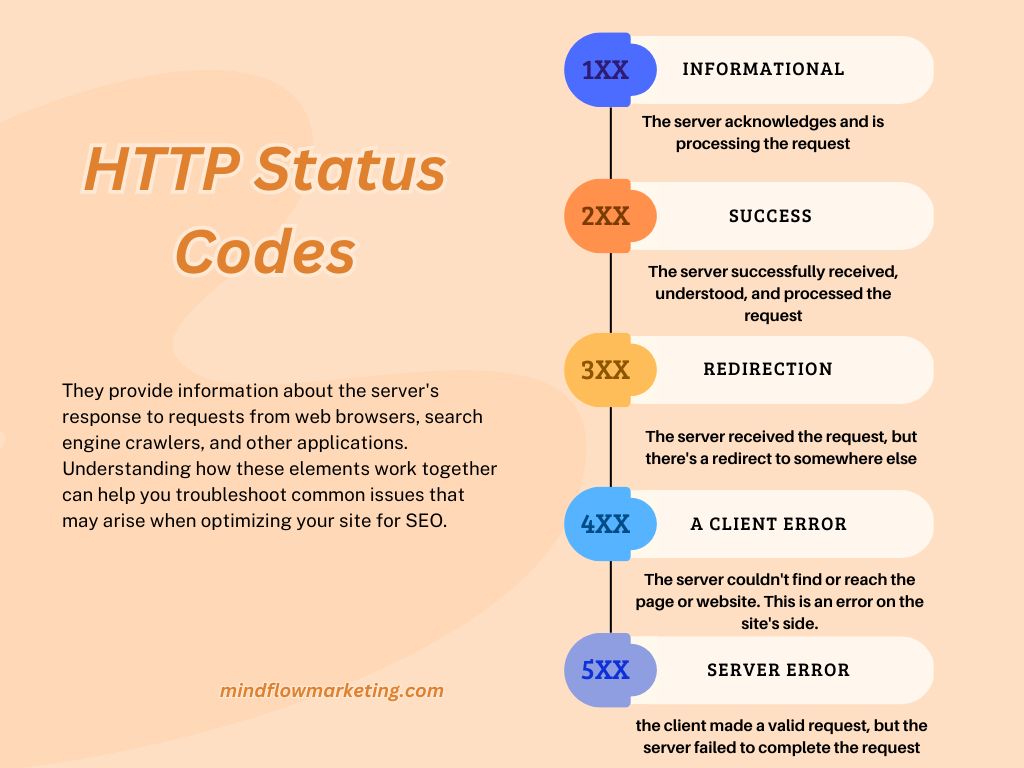One key component for SEO success is HTTP status codes and headers. Understanding how these work, what types exist, and best practices for using them can be a great asset when optimizing your site’s visibility to potential customers or clients.
This blog post will cover everything you need to know about HTTP status codes and headers for SEO – from basic definitions to troubleshooting common implementation issues.

What Are Http Status Codes?
HTTP status codes are important to search engine optimization (SEO). They tell the search engine what is happening with a web page.
When you enter a URL into your browser, it sends a request to the server hosting that page. The server then responds with an HTTP status code which tells the browser whether it can find and serve up the requested page.
HTTP status codes are like traffic signals for search engines – letting them know whether or not they’ve reached their destination successfully – making them essential tools in ensuring good SEO performance across large and small websites!

How to Check HTTP Status Codes?
Check the HTTP status code to ensure the redirect settings are correct. Furthermore, HTTP response codes can diagnose errors when the main content has been loaded, but some functionality is unavailable.
Open the browser developer tools on the error page to view the status code. Refresh the page by going to the “Network” tab. Following that, you will see a list of all HTTP requests and HTTP response status codes. To test HTTP response, you can use special programs that can check a list of URLs or crawl the entire site. Netpeak Spider, Netpeak Checker, Serpstat, Screaming Frog SEO Spider, and Urlitor are a few examples.
Google Search Console also provides the ability to obtain the exact HTTP server code usage number. Go to Settings, then Crawling, and finally, “Open Report.” You will be given a list of status codes sorted by the response. Each status code is clickable and displays detailed information about when and where it occurred.
Some HTTP Status codes

#1. 200 Ok
When a web server responds with a 200 response code, it sends additional headers that can impact how search engines handle the URL. The most important header is “Content-Type,” which tells the browser what file type to expect (HTML, CSS, JS, etc.).
Other headers include “Cache-Control,” which tells browsers and search engine bots whether or not they should cache the page; “Last-Modified,” which indicates when the page was last modified; and “Vary,” which indicates if different versions of a page are available based on certain criteria such as language or device type.
All these HTTP headers play an important role in ensuring your pages are indexed correctly by search engines.
Another common use for a 200 response code is to indicate that a redirect has taken place. A redirect is simply an instruction from one URL to another, telling browsers and search engine bots where to go next when they encounter the original URL.
Redirects can be permanent (301) or temporary (302), but both types will return a 200 status code and instructions about where to go next. It’s essential for SEO purposes that any redirects you set up don’t lead back around in circles, as this could have serious implications for your website’s visibility in organic search results.
It’s worth noting that returning a 200 response code does not guarantee crawling and indexing by Google or other major search engines – only that they’ll be able to access your content if they decide it’s relevant enough for their users’ queries.
To ensure your content gets crawled regularly, you need to ensure no technical issues are preventing them from doing so and then promote it through link-building efforts so Google knows its value and relevance compared with other sites competing for similar keywords, phrases, topics, etc.
#2. 301 Moved Permanently
A 301 redirect, also known as an HTTP status code, tells browsers and search engines that the page they’re looking for has been permanently moved. Any link metrics associated with the original URL will be passed onto the new URL.
It’s like cutting off one end of a hosepipe and connecting it to another – all the water still flows through, but now it takes a different route.
In other words, if you want to change your website address or move content around within your site, this code should be used so visitors can still find what they’re looking for, and Google won’t penalize you in its rankings.
Why are 301 Redirects Important for SEO?
301-redirects are essential tools in helping websites preserve their rankings or even improve them by ensuring all links point back to valid pages.
How Does A 301 Redirect Work?
When someone visits an old URL that has been redirected using this code, they’ll automatically be taken to the new location instead – no matter where they click from, including organic search engine results or referral sources like social media profiles.
The same goes for bots crawling webpages; if a permanent redirection is set up, crawlers will follow suit until their cache updates with new information about updated URLs accordingly.
What Impact Do 301 Redirects Have On PageRank?
A 301 redirect has the same PageRank damping factor as a link, so when page A redirects to page B, the effect is the same as page A linking to page B.
Overall, 301 redirects are an important tool in the SEO arsenal, with a wide range of useful applications that can help a website maintain or improve its rankings.
#3. 302 Moved Temporarily
What is a 302 Redirect?
A 302 redirect is an HTTP status code that indicates another URL has temporarily replaced a page. This means search engines keep the original URL in their index while users are sent to the redirect’s target URL.
In the long term, Google interprets a 302 redirect as a permanent 301 redirect and will start to handle it accordingly.
Why Would You Use A 302 Redirect?
When Should You Not Use A 302 Redirect?
It’s generally not recommended to use this type of redirection for geographic reasons because it could mean search engines like Google only see one country’s version of your site’s content instead of all versions available globally.
Additionally, too many types of redirection (301,302, etc.) can confuse visitors and search engine crawlers alike, so it should be avoided where possible.
#4. 304 Not Modified
What is the 304 Not Modified Status Code?
The 304 Not Modified status code is an HTTP response status code that tells browsers and search engine crawlers that a resource has not been modified since it was last requested. This means the client can rely on the version of the resource stored in its cache instead of requesting a new copy from the server.
Why Should You Use It?
How Does It Work?
When your browser requests a certain resource (such as an image file), it will include additional information, such as an ETag header or the Last-Modified date field, to check whether or not any changes have been made since its last visit.
Suppose no changes are detected between these two values. In that case, your browser will receive a 304 Not Modified response from the server instead of downloading another copy of the same file again unnecessarily, thus saving time and bandwidth for both parties involved in the transaction process, i.e., client & server, respectively.
#5. 307 Temporary Redirect
What is a 307 Temporary Redirect?
A 307 temporary redirect is an HTTP status code that tells the browser to resend its request using HTTPS instead of HTTP. The browser implements this due to the HSTS Preload list, which lists websites served over HTTPS rather than HTTP.
Webmasters and online marketers must be aware of this as it can affect how their website functions and users interact.
How Does a 307 Redirect Work?
When a user visits a website on the preloaded HSTS list, their browser automatically sends an HTTPS request instead of an HTTP one, even if they typed in http:website.com in their address bar. The server then sends back a 307 response code, telling the browser to re-send its request using https:website.com instead.
Once this happens, all subsequent requests from that user’s device will use HTTPS until either they or the server explicitly change it back to HTTP again (e.g., via another redirect).
Why Is It Important To Use A 307 Temporary Redirect?
#6. 404 Not Found & 410 Gone
HTTP Status Codes
The two HTTP status codes important for SEO are 404 not found and 410 gone. A 404 response indicates that the URL doesn’t exist, and Google Search Console will show these errors in the site’s Crawl Errors report.
Most often, 404 responses result from a wrong link somewhere on a website that Google discovers and then tries to crawl. A 410-gone response is an explicit request to remove a URL from Google’s index since it has been permanently removed from its original location.
Importance of Understanding Error Codes
It is important for web developers, online marketers, content managers, entrepreneurs, business owners, and other stakeholders involved in SEO to understand what each error code means so they can properly address any issues with their websites or URLs as soon as possible.
Ignoring or misunderstanding these codes could decrease rankings on search engine results pages (SERPs), ultimately negatively affecting traffic and conversion rates. Additionally, serving incorrect status codes could lead to penalties from search engines like Google if they find out about them through manual reviews or algorithmic changes.
Preventing & Resolving Errors
To prevent such misfortunes as 404 not found responses, staying on top of link-checking both within and outside your domain is wise. If you encounter any broken links, rectify them promptly so that users can avoid hiccups while navigating your website.
When dealing with URLs that have been removed permanently, instead of just leaving them alone or serving a 404 Not Found response, serve a 410 Gone one; this will inform search engines like Google that the page no longer exists without having detrimental effects on ranking positions due to old links elsewhere online.
#7. 429 Too Many Requests
What is a 429 Response?
A 429 response is an HTTP status code that indicates the client has made too many requests in a given period. This type of response usually occurs when rate-limiting technology, which prevents websites from being overloaded by external requests, is triggered.
When this happens, instead of receiving the URL’s proper response, you get the 429 response instead.
How Does Rate Limiting Technology Affect SEO Crawlers?
Rate-limiting technology can interfere with crawls on a website by SEO tools and will often require you to ask the website’s tech team to make an exception for the IP address(es) used for crawling.
Some rate-limiting technologies also block Googlebot, which can seriously affect how quickly and efficiently Google can crawl a site.
How Can You Identify if Rate Limiting Technology has blocked your Site?
Google doesn’t report 429 responses in Search Console, so it’s important to double-check that there are exceptions for valid Googlebot crawls if your website uses rate-limiting technology. It’s worth noting that although these types of errors don’t directly affect rankings or traffic levels, they may still cause problems such as slower indexing speeds or inaccurate data reporting within analytics platforms like Google Analytics.
When serving a 500 internal server error message, it is best to use the 503 services unavailable status code to inform crawlers such as Googlebot that the site has been taken down intentionally. Doing so will prevent any negative impacts on the page’s rankings in Google and allow for maintenance periods without interruption.
Additionally, if this error persists for an extended period, then Google may begin to interpret it as a persistent issue and update its index accordingly.
#8. 500 Internal Server Error and 503 Service Unavailable
Any 5XX HTTP response indicates a server-side issue. They are codes that should be avoided as much as possible.
They are fairly common, particularly on large-scale websites. In Search Console, Google reports the following server errors:
What are 5XX HTTP Responses?
5XX HTTP responses indicate a server-side problem and should be avoided as much as possible. These errors can frequently occur on large websites, and Google reports them in Search Console when they happen.
They impact crawl efficiency by causing Googlebot to reduce or stop crawling the website until the error is fixed.
Impact of 5XX Errors on SEO
These errors’ major impact on SEO is their effect on crawl rate, which can lead to delays in getting new content indexed if it persists for too long. To prevent this from happening, it’s important to keep the number of 5XX errors served at a minimum so that Googlebot doesn’t slow down its crawl rate or stop crawling altogether due to persistent issues with your website’s server-side setup.
How To Minimize The Number Of 5XX HTTP Responses?
There are several steps you can take to ensure that your website minimizes the number of 5xx responses it serves up, such as regularly checking your server logs for any potential problems; making sure all software updates are installed promptly; monitoring traffic levels closely; and ensuring adequate resources (CPURAM) allocated for each request handled by your web servers.
Additionally, implementing proper caching mechanisms can help reduce requests going directly through to backend databases and thus reducing potential bottlenecks caused by those queries taking longer than expected timespans to execute properly or return results within an acceptable timeframe range given certain user parameters being passed into them via URL query strings or form fields alike.
#9. HTTP Headers
Headers provide more detailed information about requests than just status codes alone. They can include cookies, authentication credentials, cache control settings, and other data related to client requests.
For example, make an API call using the curl command line tool. You will see various headers sent back in response, including the Content-Type header, which specifies what type of content is being returned by the server, along with the Cache-Control header, which helps browsers determine how long they should store resources locally before requesting them again from the server, etc.
Best Practices for Using HTTP Headers
HTTP headers provide information about the type of content on a page, how it should be cached and stored, and what security measures are in place to protect users. By correctly understanding HTTP headers and using them, you can improve your website’s performance and visibility in search engine results pages (SERPs).
Caching headers tell browsers how long they should store webpages before requesting new versions from the server. This helps reduce load times by allowing visitors to quickly access previously loaded content without waiting for a new version to download.
To set caching headers, use the “Cache-Control” header with values such as “max-age=” or “public,” which will allow browsers to cache resources for up to seconds or indefinitely, respectively.
Content-type headers let browsers know what type of data is being sent so that they can properly interpret it when displaying a webpage. For example, if you have an image file on your site, you would want the browser to recognize it as an image instead of plain text or HTML code.
To do this, use the “Content-Type” header with values such as “image/jpeg” or “text/html; charset=utf8″.
Security headers help protect users from malicious attacks by setting rules around which types of requests are allowed on your site and how those requests should be handled.
Common security headers include X-Frame Options (which prevents clickjacking attacks), XSS Protection (which blocks cross-site scripting attempts), and Content Security Policy (which sets restrictions around which scripts can run).
All three of these should be used together to maximize protection against potential threats.
Compression headers allow servers to compress files before sending them over the network. This reduces bandwidth usage and speeds up loading times significantly – especially on mobile devices where internet connections are slower than desktop computers due to their limited signal strength range.
To enable compression, use either gzip or deflate encoding via the “Accept-Encoding” header with values like “gzip” or “deflate.”
Troubleshooting Common Issues with HTTP Status Codes & Headers
They provide information about the server’s response to requests from web browsers, search engine crawlers, and other applications. Understanding how these elements work together can help you troubleshoot common issues that may arise when optimizing your site for SEO.
When it comes to HTTP status codes, there are five main categories:

Each code provides specific information about the request being made by the browser or application. For example, a 200 OK code indicates that the request was successful, while a 404 Not Found code means that the requested page does not exist on the server.
Incorrect redirects can be another issue with HTTP status codes and headers. Redirects should always point to valid pages; if they don’t, this could lead to problems with indexing and user experience issues, such as broken links or dead ends in navigation menus.
To ensure correct redirects are in place, use 301 permanent redirects instead of 302 temporary ones whenever possible – this will tell search engines that you want them to update their records accordingly, so users end up at the right destination page each time they click on an internal link within your site structure.
Another issue is incorrect caching settings which can cause content delivery delays or even prevent certain pages from loading altogether due to outdated versions being served instead of fresh content from your servers.
To fix this problem, ensure all cache-control headers have been set correctly so browsers know when they should check for new updates before displaying any page element on screen – this will also improve overall performance since cached resources take less time to load than non-cached ones do!
Conclusion
We have included a small selection of HTTP status codes and HTTP headers. If this article piqued your interest, there are numerous resources available on the web to help you learn more about the HTTP protocol and the web’s client-server architecture, such as:
Learning about this aspect of the web will help you be a more effective SEO and will also help you in other areas of digital marketing.
After all, our work is primarily focused on the web, so a better understanding of the web’s underlying technologies is extremely beneficial.